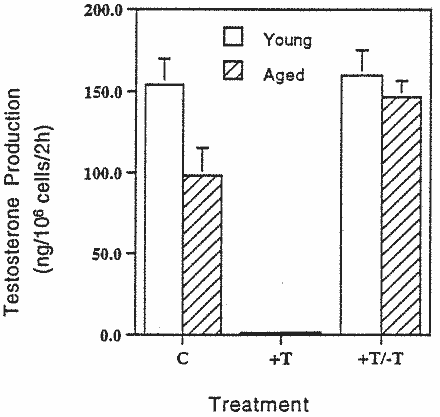
Long-term suppression of leydig cell steroidogenesis prevents leydig cell aging
Researchers: Chen H, Zirkin BR
Division of Reproductive Biology, Department of Biochemistry and Molecular Biology, Johns Hopkins University, School of Hygiene and Public Health, 615 North Wolfe Street, Baltimore, MD 21205, USA.
Source: Proc Natl Acad Sci U S A 1999 Dec 21;96(26):14877-81
Summary:
Based on the observations that reactive oxygen is capable of damaging components of the steroidogenic pathway and that reactive oxygen is produced during steroidogenesis itself, we hypothesized that long-term suppression of steroidogenesis might inhibit or prevent age-related deficits in Leydig cell testosterone production. To test this, we administered contraceptive doses of testosterone to groups of young (3 months old) and middle-aged (13 months old) Brown Norway rats via Silastic implants to suppress endogenous Leydig cell testosterone production. After 8 months, the implants were removed, which rapidly (days) restores the ability of the previously suppressed Leydig cells to produce testosterone. Two months after removing the implants, when the rats of the two groups were 13 and 23 months of age, respectively, the Leydig cells in both cases were found to produce testosterone at the high levels of young Leydig cells, whereas significantly lower levels were produced by the 23-month-old controls. Thus, by placing the Leydig cells in a state of steroidogenic “hibernation,” the reductions in Leydig cell testosterone production that invariably accompany aging did not occur. If hormonal contraception in the human functions the same way, the adverse consequences of reduced testosterone in later life (osteoporosis, reduced muscle mass, reduced libido, mood swings, etc.) might be delayed or prevented.
Discussion:
OK, I will admit that I am biased about the use of androgens. Frankly, I think politicians and the popular press have unjustly vilified them. This being the case I tend to take notice to studies involving androgens. This particular study was a real surprise.
Male aging is accompanied by reduced testosterone production by the Leydig cells, the testosterone-producing cells of the testis. The mechanism by which this occurs is unknown. In the above study they suppressed testosterone production with androgen implants in male rats for eight months. The researchers called this behavior of the testes as “steroidogenic hibernation”.

This is the same phenomenon that all male bodybuilders experience when using testosterone of other androgens. After removing the hormone implants they measured the ability of the leydig cells to produce testosterone by bathing them in luteinizing hormone (LH). They measured testosterone production as well as steroidogenic enzyme activities. As you can see from the graph above, the leydig cells of old rats that had their testosterone production temporarily shut down, retained their ability to produce testosterone equal to young rats. The activities of each enzyme tested were significantly lower in Leydig cells from the 23-month-old control rats compared with the 13-month-old control rats. All the steroidogenic enzyme activities were reduced in Leydig cells isolated from 11- and 21-month-old rats tight after exogenous testosterone treatment for 8 months. Two months after the implants were removed, when the rats were 13 and 23 months of age, respectively, the activities of each of the suppressed enzymes were at the high levels of 13-month-old control rats, in each case significantly higher than those of the 23-month-old controls.
The researchers hypothesize that this phenomenon is the result of decreased oxidative damage to leydig cells. In the course of normal cell function, reactive oxygen species are produced and can cause damage to DNA, proteins (e.g. enzymes), and cell membranes including mitochondrial membranes. This could contribute to age related loss of testosterone production. It is known that reactive oxygen species can damage the steroidogenic pathway in vitro (Quinn, 1985).
The authors of this study considered the dose of testosterone needed to accomplish this as a “contraceptive” dose. In men this is about 100 mg testosterone enanthate per week. They will usually throw in some progesterone too. This is far below what you would need to be a competitive bodybuilder. It could be that in doses used by larger bodybuilders is too much and may actually cause permanent losses in testosterone production. On the other hand, these doses might be equally effective or even more so than contraceptive doses. Time will tell. In any case, a preservation of testosterone production in later life means decreased risk of osteoporosis, sarcopenia, loss of strength, mood swings, etc. Appropriate studies carried out on humans is clearly needed.
Quinn PG, Payne AH. Steroid product-induced, oxygen-mediated damage of microsomal cytochrome P-450 enzymes in Leydig cell cultures. Relationship to desensitization. J Biol Chem 1985 Feb 25;260(4):2092-9
Leave a Reply
You must be logged in to post a comment.